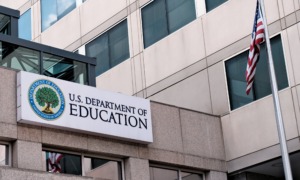
szefe/Shutterstock
.
The Family First Act, that vastly overhyped law that, according to those doing the hyping, is supposed to revolutionize child welfare finance and greatly improve services to families whose children are at risk of being placed in foster care, is off to an inauspicious start.
Rather than helping families, the first set of proposed guidelines to be issued under Family First may make things worse. The guidelines concern standards for licensing foster homes. They were issued by the Department of Health and Human Services (HHS) on Aug. 1 and comments are due by Oct. 1.

Richard Wexler
If the current draft is finalized it will discourage the least harmful form of foster care — kinship foster care, in which children are placed with extended family members instead of total strangers. One particularly cruel guideline may violate existing federal law.
It’s not clear exactly how much harm these guidelines would do, because there is no mechanism in the law for enforcement. But at a minimum, in some states, they would encourage states to make it harder for relatives to become foster parents. That’s why the California Department of Social Services is up in arms about them.
That agency is circulating to key players in child welfare in that state a draft of a smart critique of many of the guidelines. The National Coalition for Child Protection Reform has obtained a copy of the draft, which concludes by urging HHS “to consider the diverse population of our state, especially of the children in care, and the necessity of having standards that are inclusive of potential applicants and do not exclude applicants, particularly relatives.”
Underlying the problems with the guidelines is a more fundamental issue: Licensing was created in an era when foster care was provided almost exclusively by middle-class strangers. It makes no sense to try to craft a single set of regulations to apply to them and also to relatives. Those relatives typically bring an enormous extra bonus to the table — the love of a family member. But, because most children taken from their parents are poor, most extended family members also are poor. That creates a need for more flexibility in regulations.
The value of kinship care
The first thing to understand about kinship care is that it is, by far, the least harmful form of foster care. Multiple studies have found that kinship care typically is better for children’s well-being, more stable and, most important, safer than what should properly be called stranger care. That is true even when the kinship foster home is not licensed.
Similarly, when the late George Sheldon was running the Florida Department of Children and Families and started demanding that the agency crack down on the misuse and overuse of psychiatric medications on foster children, they found that such medication is used far less often when the caregivers are relatives.
That’s why smart child welfare systems don’t bog down grandparents and other relatives with cumbersome, bureaucratic licensing requirements. But, of course, there are not that many smart child welfare systems.
Some child welfare systems don’t require relatives to be licensed, but many do. Others, such as the system in Allegheny County, Pa., require licensing but will move heaven and earth to help relatives meet licensing requirements. But very few go to such lengths.
There are benefits to being licensed, both for the relatives and for child welfare agencies. The federal government will only reimburse part of the cost of kinship foster care if the foster home is licensed. And, if the home is licensed, the state must pay the relatives the same foster care rate it pays strangers. When the home is not licensed, relatives often get far less.
The limits of licensing
But there also are good reasons why many kinship care parents can’t be licensed or don’t want to be licensed. Some relatives simply have had such bad experiences with child protective services agencies that they want the agency’s presence in their lives kept to a minimum.
But there’s also a more practical reason. Licensing regulations typically are of the middle class, by the middle class for the middle class. They are geared more to middle-class creature comforts than to setting minimum health and safety standards.
Some states have minimum square footage requirements and specify how many children can sleep in the same room. Michigan’s 12 single-spaced pages of regulations include 40 specifications just for bedrooms. There are at least two states where the regulations are so strict that the condominium where President Obama was raised by his grandmother probably would not qualify as a kinship care home.
And Michigan is where the harm of overly bureaucratic licensing was made most dramatically apparent. A requirement that all foster homes be licensed was inflicted on the state in 2008 as a result of a consent decree growing out of a lawsuit brought by the group that calls itself Children’s Rights. Even homes that already had children would have to be licensed — or the children could be kicked out.
At the time, Michigan had been a national leader in kinship care. But, after the consent decree, Michigan and much of the rest of America started moving in opposite directions. In the first six years after the licensing requirement took effect, the proportion of children in kinship care in Michigan actually declined by 15 percent, before finally improving again in 2015. Nationwide, during the same period, the proportion of children in kinship care increased by 20 percent.
The federal government steps in
Although the federal government long has refused to pay for kinship care if a foster home isn’t licensed, it has never issued recommendations for licensing. But Family First requires HHS to do just that. Congress instructed HHS to see what’s already out there and pull together a set of model standards. But it appears that nothing will actually happen to states that don’t meet those standards.
The law requires states to tell HHS if their own standards are in accord with the HHS model. If not, the state needs to explain why a given standard in the national model “is not appropriate for the state.” But that’s all.
The good news: The standards reflect some awareness of the problems involved in imposing licensing burdens on kinship families. Some of the proposals are taken from guidelines first developed by the American Bar Association and Generations United, a group that has championed kinship care — though even some of those are problematic. And some of HHS’ proposed model guidelines are better than what now exists in many states.
In addition, current federal law allows — but does not require — states to waive some requirements for kinship caregivers if they are not related to health and safety. The Family First Act requires states to tell the federal government if they’re doing that and how they are doing it. But it does not require such waivers.
But, as the California DSS draft letter makes clear, the proposed standards still have serious problems. The letter compares the HHS proposals to the state’s own standards, which emphasize flexibility to accommodate the special circumstances of extended families.
An assault on ‘normalcy’
Consider for starters a cruel assault on “normalcy.”
There are so many big things wrong with foster care that it’s easy to forget all the little things that, together, can make foster children second-class citizens, make their experience in care miserable and undermine the work of even the best foster parents. The simple things that other children take for granted — being allowed to participate in extracurricular activities or even going on a sleepover at a friend’s house — can be a bureaucratic nightmare for foster children and foster parents.
One of the child welfare leaders who was first to recognize this was, once again, George Sheldon. While running child welfare agencies in Florida and Illinois and when he ran the federal Administration for Children and Families, Sheldon pressed for initiatives that would promote “normalcy” for foster children.
Since 2014, that’s been part of federal law. The law now requires states to let foster parents make these sorts of decisions, applying a “reasonable and prudent parenting standard.”
So I’m sure that, had the requirement to issue foster home licensing guidelines arisen when Sheldon was running ACF, he never would have allowed such proposed guidelines as one that allows only “members of the household” to provide transportation for a foster child.
Under this guideline, if the parent of the friend who’s having the sleepover wants to pick up and drop off the foster child? Not allowed. If that parent wants to take the friend and the foster child for an outing at an amusement park? Not allowed. If the foster parent doesn’t know how to drive? The foster child is stuck at home.
Though the commentary accompanying this proposed guideline states that “We specifically avoid proposing standards that could impact a foster parent based on geographic location and income,” this proposal does exactly that. As the California letter points out:
“The proposed national model would discriminate against single applicants unable to transport a child due to work schedules and/or those with medical conditions or disabilities that do not allow the applicant to drive. Children in foster care have the right to maintain their school of origin, receive medical, dental, vision and mental health services, attend religious services and activities of his or her choice, to have contact with family members, to participate in extracurricular activities, etc. In order to ensure the child’s rights are being met, arrangement of other transportation is often necessary.”
While this rule would harm children in all forms of foster care, there’s a disproportionate effect on kinship caregivers. After all, a grandparent is more likely to be unable to drive, and an aunt or uncle might be single.
Then there are the guidelines that clearly come with middle-class families in mind:
The proposed federal guidelines require that homes have a sink, a toilet and a shower or bathtub all in the same room. California’s standard, in contrast, “does not require that these elements be in one room in order to accommodate for homes in the rural counties of the state where the toilet, for example, may be in a separate room by itself.”
The federal guidelines also call for requiring the foster home to have not just smoke and carbon monoxide detectors but also a fire extinguisher. As the California letter explains, “The requirement of a fire extinguisher can place undue hardship on applicants with limited means to purchase extra items as part of the approval process.”
Other standards don’t cost more money but still suggest that whoever came up with them doesn’t get that a family is not an institution. So there’s a requirement that a written evacuation plan be posted prominently in every foster home — the sort of thing you would see in an institution. If you don’t have such a plan posted in your living room, chances are foster homes don’t need one either.
Still other proposed guidelines concerning how to verify the physical and mental health status of everyone in the household and where to interview those household members are too rigid for low-income families. California’s approach doesn’t eliminate these requirements, but it makes the process for compliance more flexible.
A foolish consistency
But the primary problem with the whole effort is the idea that licensing standards for kin and strangers should be identical. It makes sense, for example, to require of strangers taking in children that they speak the same language as the child and the larger community. But what if the child speaks Spanish and the larger community speaks English? A Spanish-speaking grandma almost always would be better than a bilingual stranger. So the same blanket regulation should not be applied to both.
HHS and the states need a whole new approach, one that recognizes that any risks associated with things such as not having a fire extinguisher in the home or letting a foster child’s friend’s father drive him to a soccer game are outweighed by the love and caring that extended family members have to offer.
For starters, guidelines should require states to reimburse kinship care families for expenses related to meeting the guidelines or simply provide whatever is needed to ensure compliance. If a state really wants a fire extinguisher in every kinship care home, for example, then the guidelines should require the child welfare agency to provide the fire extinguisher.
But even more important, any approach to kinship care licensing should begin with one guideline. The guideline is not absolute; there are some obvious exceptions. But most of the time, the starting point should be as follows: Is the proposed regulation something that parents have to comply with when raising their own children? If the answer is no, then there is a good chance it shouldn’t be required of grandma either.
Richard Wexler is executive director of the National Coalition for Child Protection Reform.





























